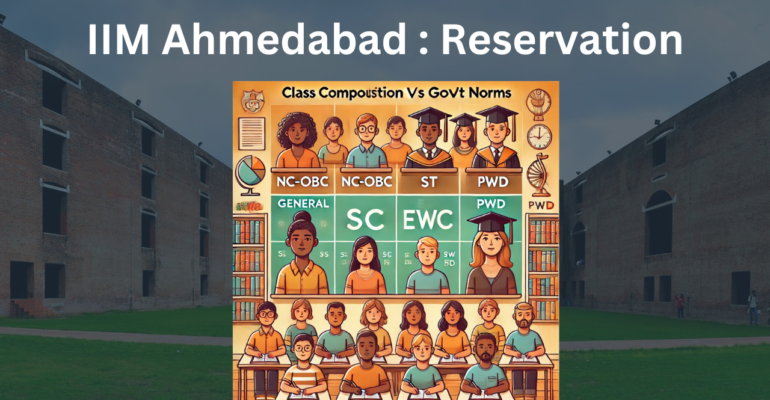IIM Ahmedabad Reservation
August 10, 2024 2024-08-11 2:21IIM Ahmedabad Reservation
Table of Contents
ToggleUnderstanding Class Composition in Relation to Government Norms
In educational institutions, particularly those of higher learning such as the Indian Institutes of Management (IIMs), class composition is crucial for ensuring diversity and inclusion. Government regulations mandate specific reservations for various categories to promote equal opportunities for all segments of society. This blog post dives into the class composition of the PGP (Post Graduate Program) and FABM (Food and Agribusiness Management) courses, comparing them with the government-mandated norms.
Government Reservation Norms
As per the Government of India requirements:
-
- 27% of seats are reserved for NC-OBC (Non-Creamy Layer Other Backward Classes).
-
- 15% of seats are reserved for SC (Scheduled Castes).
-
- 7.5% of seats are reserved for ST (Scheduled Tribes).
-
- 5% of seats are reserved for PwD (Persons with Benchmark Disabilities).
-
- Up to 10% of seats can be reserved for EWS (Economically Weaker Sections).
These norms are designed to ensure that students from underrepresented and economically disadvantaged sections of society have access to quality education.
Class Composition: PGP and FABM
Let’s take a closer look at the class composition for the PGP and FABM courses at an IIM. We have a table that outlines the number of students in each category, their percentage, and how these figures compare with government norms.
| Category | PGP Number | FABM Number | PGP % | FABM % | Government Norms (%) |
|---|---|---|---|---|---|
| GEN | 189 | 23 | 47% | 49% | – |
| EWS | 9 | 1 | 2% | 2% | Up To 10% |
| NC-OBC | 101 | 12 | 25% | 26% | 27% |
| SC | 56 | 7 | 14% | 15% | 15% |
| ST | 29 | 3 | 7% | 6% | 7.5% |
| PwD | 20 | 1 | 5% | 2% | 5% |
| Total | 404 | 47 | 100% |
From the table, it’s evident that the general category (GEN) constitutes a significant portion of the class. However, when compared with government norms, there are discrepancies in some categories, such as the underrepresentation of EWS and PwD in both courses.
Visual Representation
Class Composition with Government Norms
PGP Course: Comparison with Government Norms
Conclusion
Understanding and analyzing class composition in relation to government norms is essential for educational institutions committed to inclusivity and diversity. This analysis not only helps in identifying gaps but also serves as a benchmark for future improvements.
Institutions must continue to monitor and adjust their admission processes to ensure that they meet or exceed government norms, thereby fostering a more inclusive and equitable learning environment.























Search
Featured Courses









